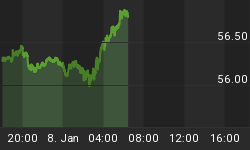Timing attempts to provide market equivalent returns over the long term, with a substantial reduction in variability of returns. The two components of the Timing program are EZ+Macro and Fear/Greed. This system trades rarely and splits its allocations between ETFs tracking the S&P 500, the intermediate-term U.S. Treasuries, and cash.
Information is as of the close on November 16, 2007.
EZ+Macro
EZ Trend is up for the U.S. stock market as approximated by the S&P 500. While the U.S. Ten-Year Treasury price is also bullish by EZ Trend, my latest backtesting hasn't indicated that a position in bonds is warranted in this EZ+Macro configuration.
Fear/Greed
The Fear/Greed model signaled a buy for the U.S. stock market in early November. It would signal a sell only if $VIX relative to actual volatility fell to a historically low level. This is a tough model to follow, as it demands a buy and hold when fear is high and most people would like to sell.
Model Allocation
S&P 500 SPDRs (SPY) - 100%
iShares 7-10 Year Treasury Bond Fund (IEF) - 0%
Cash - 0%
Tracking
There are no changes to the allocation from last week's message.
Charts and Commentary
My charts are 700px wide and this site is best viewed at 1280×1024. If the chart is truncated in your browser, click to view it in full size.

(1) EZ Trend components. This is the lowest the spread has been in the past 52 weeks, but the signal is a cross of the averages, not a spread distance.
(2) Fear/Greed buy signal. As long as options estimates of S&P 500 volatility are spiking in relation to actual volatility, this system will be on a "buy" signal. Monday's market drop may have been distressing to many long traders, but that very distress was a bullish signal by this method.
(3) Note that all price action in the last week was contained in the congestion period marked during the July to September correction.
(4) Volume spike, with a long lower wick on the candle chart, on July 26. Lower prices were tested and the index bounced back to a large degree, then fell more on the following day with volume that was slightly lower, but still significantly above the average volume at that time. Most of the price action in the remainder of the correction stayed near that second day's price range.
(5) Looks familiar to me. No guarantee that it will play out the same, but I'm not thinking there's much downside here.
(6) 2-day RSI is neither oversold nor overbought. Any short-term signal is probably days away.
Note the breadth in the following charts.



The index is near low levels in breadth that have, over the last several years, indicated being at a significant bottom. I don't have information going back before the recent five-year bull market, so I can't compare this to the breadth indicators of the bear in 2001-2. Monday's drop made the breadth measurements on the 50- and 200-day simple moving averages worse than they were at last week's message, but breadth has improved since then. Bullish percent has fallen, however. The Bullish Percent Index (BPI) is a popular market breadth indicator that is calculated by dividing the number of stocks in a given group (an exchange, an industry, etc.) that are currently trading with Point and Figure buy signals, by the total number of stocks in that group. I am likely to consider very low breadth as a contrary buy signal. There's no guarantee that the members of the index won't become more oversold as a group, but I view it as unlikely to happen here.
Regression models show 90/100 for 20-day "potential" and 79/100 for 20-day "safety." Twenty trading days is approximately a month. These are bullish values. I don't include the regression model in the timing system because I specifically want the system to be "lazy" i.e. not trading very often.
















